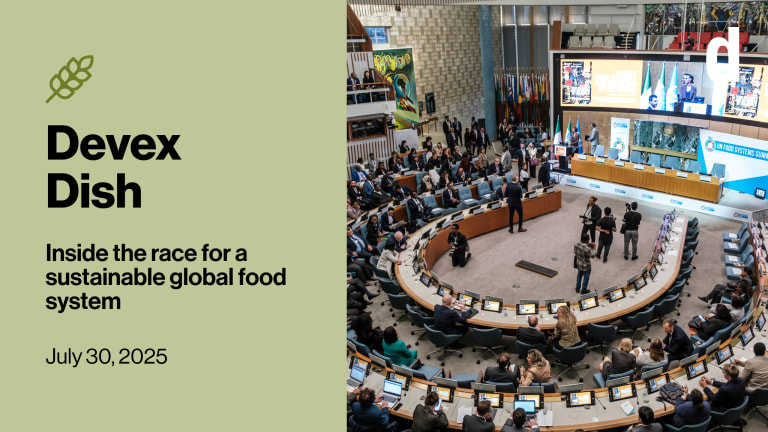
Many politicians have used the language of war to describe efforts to control COVID-19, having to defeat the “invisible enemy.” In war, truth is often the first casualty. So it is tempting to say that good-quality data on hunger and malnutrition have been a casualty of the preoccupation with disease control during the pandemic. The truth is that the data were never remotely fit for purpose — even before the crisis.
The environmental impact of balancing the food system is still unknown
"We don't know much about what people eat," says Lawrence Haddad, executive director at GAIN. Data gaps and conflicting research related to diet — a major influence on climate emissions and health — remain as challenges to changing the global food system.
As COVID-19 takes its toll on lives and livelihoods around the world, the pandemic risks becoming a global food emergency. This is unfolding on top of what was already a daily crisis for the more than 820 million people in the world who are chronically hungry and the 1 in 3 people globally who suffer from poor nutrition.
We know that things are already worse for the poorest and most vulnerable in all countries, but it is difficult to say how much worse, for whom, and for how long.
The pandemic has exposed dangerous deficiencies and fragilities in our food systems, with the ramshackle nature of food data as one of the great “reveals”. The lockdown is taking a wrecking ball to supply chains and destroying demand, and yet we have virtually no real-time data about food shortages, food reserves, food price spikes, people missing meals, and kids losing drastic amounts of weight. More urgently, specific data could help for a quick response to the looming hunger and malnutrition crisis that many experts predict is coming.
While countries around the world need to prioritize access to healthy food, nutrition, and aid to the poor, in the recovery they face a choice: return to normal or “build back better.” The United Nations’ “Food Systems Summit” is a process that has just started, and over the next year and a half, the process will build on new ideas and information to transform the way we produce, process, market, and consume food. The summit will be inclusive and action-oriented. Never before have we needed such commitment, investment, and action toward our food systems.
To make this transformation happen better and faster, we need a revolution in data collection, organization, and sharing.
On data collection, big data sourcing from private transactions has good possibilities and, to its credit, the Food and Agriculture Organization is using crowdsourced data on food prices. But we also need to bring data collection into the 21st century. Routine data collection is screaming out to be digitalization via text messaging, smartphones, and tablets.
The lockdowns in many countries have already given data digitalization a big push. Living with this new reality, digitalization has become a basic necessity — as basic as the need for running water and electricity.
Data organization also needs a big push. At the moment, food system data are disorganized and difficult to find, connect, and use. The new Food Systems Dashboard will bring together public and private sector data for 230 countries and territories and 170 indicators to describe countries’ food systems, help identify opportunities to transform them, and link to actions that have a good chance of working.
This potentially powerful tool needs to be fueled by solid, up-to-date information. A case in point is that, for each country, the dashboard provides data on food supply chains, food environments, individual factors — such as a person’s economic status, thought process, dreams, and aspirations — and overall life situation, including income, remittances, consumer behavior, diets and nutrition, and environmental, social, political and economic drivers. These are all factors that push or pull the food system, and the country profiles are meant to tell a story about the system in each nation.
Policymakers in a ministry of health, for instance, can look at country-level data about people’s intake of fruits, vegetables, and whole grains, as well as nutrition and health outcomes such as high blood pressure, which may indicate a correlation between lower intakes of these nutritious foods and a higher prevalence of high blood pressure. The data can be compared across countries by region, food systems type, or income classification to inform public health policies and promote increased intake of these foods.
By the same token, policymakers would also be able to look at long-term average annual precipitation in their country and how this is changing over time in the face of climate change. This, paired with data on the percent of cultivated land equipped for irrigation, can help inform decisions how to best utilize their agricultural water sources to increase yields of key crops.
Viewers will also be able to capture these components in an infographic-type visual that is easy to understand, shows the connections, and can be downloaded for dissemination purposes.
On data sharing, health system researchers have shown the way. There are encouraging signs of efforts by researchers working in food systems to link up models that focus on food consumption with models that focus on infant mortality. The technical issues are tough, and data sharing does not come naturally. But the enormous threats and opportunities we face demand that egos and logos are checked at the doors of collaboration.
The coronavirus crisis has revealed many truths about the strength and fragility of our food systems and the importance of good-quality data. Never before have so many people been so thirsty for numbers, viewed so many dashboards, or talked so fervently about international data comparability. Never before have scientists and researchers become such household names. Never before has it been so hard to ignore inconvenient truths.
We need a food data revolution to accompany this potential food data revelation.
Investments in food, hunger, and malnutrition data are not headline-grabbing. The data are not deemed essential — until having the data is essential, when hunger surges, food prices skyrocket, and we see panic turn into violence. By then, it is too late.
In 2020, we have to have the 20/20 vision to see the food systems we want, fed by good-quality information to get us there. Only in this way can we transform food systems to ensure the health of our people and our planet for our generation and the ones to come. We are not in a war, but we are in a race against time to save and improve millions of lives, and good data is the accelerant.









